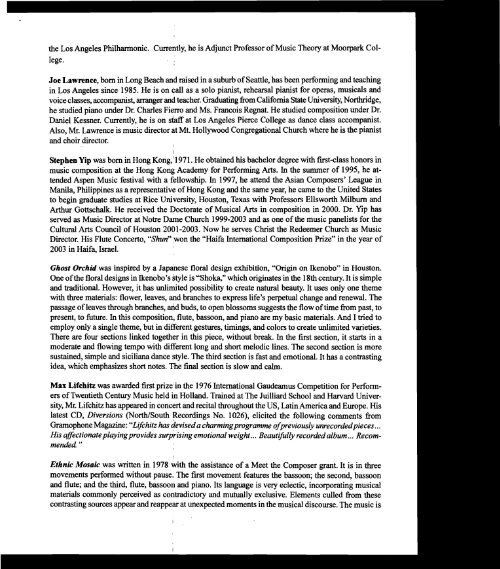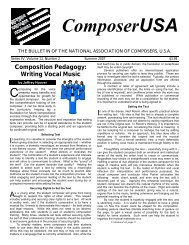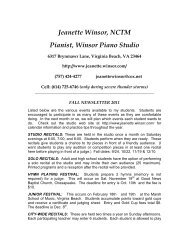1999-2007 - Music-USA.org
1999-2007 - Music-USA.org
1999-2007 - Music-USA.org
You also want an ePaper? Increase the reach of your titles
YUMPU automatically turns print PDFs into web optimized ePapers that Google loves.
the Los Angeles Philharmonic. Currently, he is Adjunct Professor of <strong>Music</strong> Theory at Moorpark College.<br />
, I<br />
Joe Lawrence, born in Long Beach and raised in a suburb of Seattle, has been performing and teaching<br />
in Los Angeles since 1985. He is on call as a solo pianist, rehearsal pianist for operas, musicals and<br />
voice classes, accompanist, arranger and teacher. Graduating &om California State University, Northridge,<br />
he studied piano under Dr. Charles Fierro and Ms. Francois Regnat. He studied composition under Dr.<br />
Daniel Kessner. Currently, he is on stlaff at Los Angeles Pierce College as dance class accompanist.<br />
Also, Mr. Lawrence is music director at Mt. Hollywood Congregational Church where he is the pianist<br />
and choir director. I<br />
Stephen Yip was born in Hong Kong, '1 971. He obtained his bachelor degree with first-class honors in<br />
music composition at the Hong Kong Academy for Performing Arts. In the summer of 1995, he at-<br />
tended Aspen <strong>Music</strong> festival with a fellowship. In 1997, he attend the Asian Composers' League in<br />
Manila, Philippines as a representative of Hong Kong and the same year, he came to the United States<br />
to begin graduate studies at Rice University, Houston, Texas with Professors Ellsworth Milbum and<br />
Arthur Gottschalk. He received the Doctorate of <strong>Music</strong>al Arts in composition in 2000. Dr. Yip has<br />
served as <strong>Music</strong> Director at Notre Dame Church <strong>1999</strong>-2003 and as one of the music panelists for the<br />
Cultural Arts Council of Houston 2001-2003. Now he serves Christ the Redeemer Church as <strong>Music</strong><br />
Director. His Flute Concerto, "Shun" :won the "Haifa International Composition Prize" in the year of<br />
2003 in Haifa, Israel.<br />
Ghost Orchid was inspired by a Japanese floral design exhibition, "Origin on Ikenobo" in Houston.<br />
One of the floral designs in Ikenobo's style is "Shoka," which originates in the 18th century. It is simple<br />
and traditional. However, it has unlimited possibility to create natural beauty. It uses only one theme<br />
with three materials: flower, leaves, and branches to express life's perpetual change and renewal. The<br />
passage of leaves through branches, arid buds, to open blossoms suggests the flow of time from past, to<br />
present, to future. In this composition, flute, bassoon, and piano are my basic materials. And I tried to<br />
There -are four sections linked together in this piece, without break. In the first section, it starts in a<br />
moderate and flowing tempo with different long and short melodic lines. The second section is more<br />
sustained, simple and siciliana dance style. The third section is fast and emotional. It has a contrasting<br />
idea, which emphasizes short notes. The final section is slow and calm.<br />
Max Lifchib was awarded first prize' in the 1976 International Gaudeamus Competition for Perform-<br />
ers of Twentieth Century <strong>Music</strong> held in Holland. Trained at The Juilliard School and Harvard Univer-<br />
sity, Mr. Lifchitz has appeared in concert and recital throughout the US, Latin America and Europe. His<br />
latest CD, Diversions CNorth/South Recordings No. 1026). elicited the followine comments from<br />
Gramophone Magazine: "Lifchitz has devised a charmingprogramme ofpreviously unrecordedpieces . . .<br />
His affectionate playing provides surprising emotional weight ... Beautifully recorded album ... Recom-<br />
mended "<br />
Ethnic Mosaic was written in 1978 with the assistance of a Meet the Composer grant. It is in three<br />
movements performed without pause. The first movement features the bassoon; the second, bassoon<br />
and flute; and the third, flute, bassoon and piano. Its language is very eclectic, incorporating musical<br />
materials commonly perceived as contradictory and mutually exclusive. Elements culled from these<br />
contrasting sources appear and reappear at unexpected moments in the musical discourse. The music is




